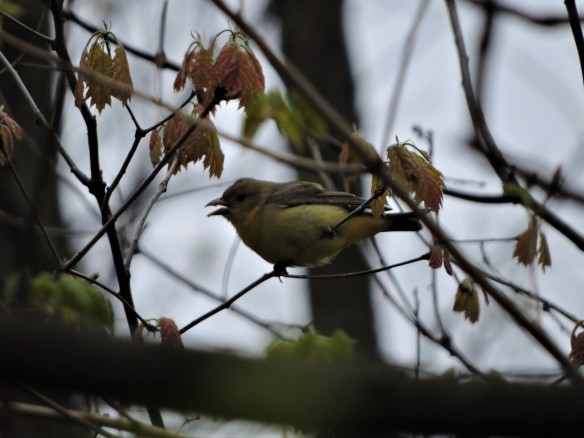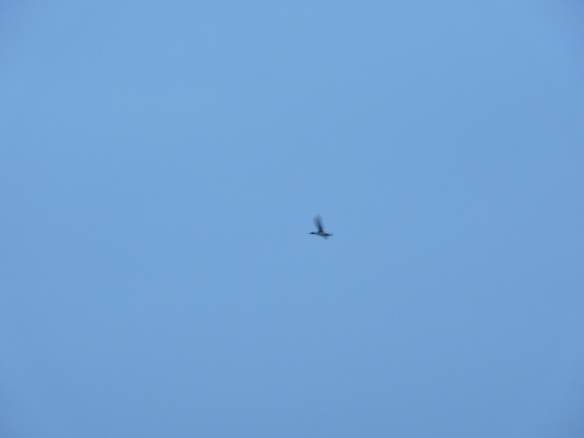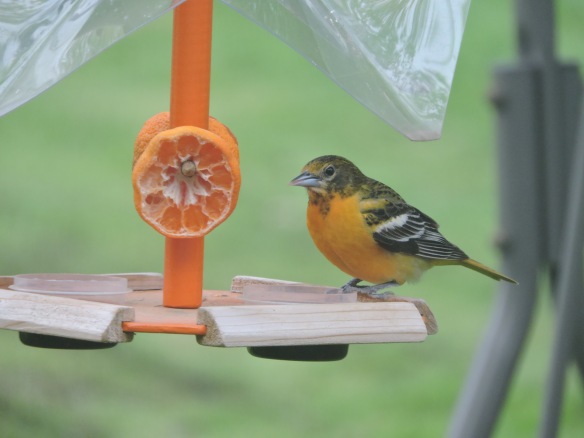This past week on the southwestern shores of Lake Erie was an event called “The Biggest Week in American Birding.” Held at the famous Magee Marsh, all kinds of tired migrants cram into a little bottleneck of woods before they make the trip across the Great Lakes, and views of otherwise difficult to see species are up close and personal, and incredible. I wasn’t there. But I had a pretty big week of my own.

Harris’s Sparrow
The evening of May 2nd I left the gym to discover an email from my birding friend Angie telling me that she had a Harris’s Sparrow in her yard. First thing the next morning I went over to check for the bird and found it singing in a tree by her driveway. Life bird, and first county record! Angie’s house is inside of my 5MR, so it also counts as the most improbable bird on that list to date! Angie has done a great job of turning her back yard into a wet woodland habitat, so if this bird were to pick anyone’s house to set up shop it would be hers. But this mind-blowing sighting got me wondering how many other crazy birds turn up at people’s feeders without ever getting recognized for what they are?

The Magic Tree
Later in the week I met up with another birding friend, Lorenzo, to check out Franke Park again for some spring migrants. The weather was total crap with drizzle and clouds the whole morning. But the birding was magical. Photos were incredibly difficult to come by, but to give you an idea of the birdsplosion happening, take the photo above which contains four Brown Thrashers (yellow circles) and two male Rose-breasted Grosbeaks (red circles). At one point another thrasher and an Indigo Bunting were also clustered with that group at the top of the tree. We just kept giving each other “what is happening?” looks as the birds. just. kept. coming.

Scarlet Tanager
We got tons of first-of-the-year birds, like this mellow female Scarlet Tanager and about five of her closest friends.

Black-throated Blue Warbler
We also had double-digit warbler species, including this unabashedly confiding (and spectacularly handsome) male Black-throated Blue Warbler who was hopping around basically at our feet. He was only the second one I had ever seen.

Laughably Bad Common Loon
As I already said, photos were basically not happening. But a couple of birds on the park’s decently sized lake made me try anyway. Two Common Loons that took off and circled low before flying away represented a long-overdue state nemesis for me! I had previously seen them up and down the United States from Minnesota to Ohio to Florida, but never in my home state. If there was any day for them to finally go down, it was this day.

Tiny Wetland
The last place we checked, just because we figured why not, was the tiny scrap of wetland behind the BMX track at the park. I usually only bother with this little parcel of swamp if I need a Red-winged Blackbird or something. It’s tiny, barely even a pond. This photo shows literally the entire thing (as well as the raindrops on my lens).

Sora!
But wouldn’t you know it, this little postage stamp of wetlands held not one but two Soras, a Marsh Wren, and a Common Yellowthroat, all birds that I had no reasonable hope of finding inside of my 5MR and that take a concerted multi-hour effort to get to at Eagle Marsh on my bike. Not today. As we were leaving, a van of people I knew from the Audubon Society pulled up, looking pretty miserable birding from their car in the rain. They informed us that is was slow going for them and they hoped we had better luck. We did.
In all, we tallied 59 species in barely two hours of birding, and my eBird checklist is here. I added two dozen new 5MR and Green birds for the year, including an additional personal county bird in White-eyed Vireo and an earliest ever county record of Willow Flycatcher for good measure. With the crazy good luck Lorenzo and I had in the morning, I continued to keep track of the species I saw later in the day and ended up at 64 without putting too much more effort into things. I will dub this day as the Accidental 5MR Big Day. The Official 5MR Big Day is yet to be had.

Baltimore Oriole
I’m not done! Even with the steady rain and limited birding time due to family activities for Mother’s Day, my week of birds kept getting better. My jelly feeder managed to reel in only the second Baltimore Oriole I have seen from the yard, but it was merely a sign of things to come.

Chestnut-sided Warbler in my yard
On Saturday and Sunday, a slow-moving bird tsunami swept over my yard and crushed me. Multiple singing Chestnut-sided Warblers visited the oaks around the house, which is pretty incredible because for whatever reason they are one of the harder warblers for me to get, and I hadn’t had one on my Green list since 2015. They were harbingers of a current of warblers so strong as to be almost unbelievable. Along with Chestnut-sided, I had Nashville, Tennessee, Black-throated Green, Northern Parula, Blackburnian, and Blue-winged Warblers all singing in and around my yard over the weekend, and I probably missed a few.

Another Scarlet Tanager
Two pretty bad Scarlet Tanager photos in the same post? Why yes, yes because this one was also in my yard. It shared the same tree with a Blackburnian Warbler, which seems to be a pretty consistent combo for me. Does anyone else seem to get Blackburnian Warbler at the same time they get Scarlet Tanager?

Least Flycatcher
The storm finally petered out with a muted Least Flycatcher as the last new bird in the yard, but it was still a new one for the year on my 5MR (currently at 107) and Green (currently at 105) lists. In all, I added six entirely new species to my yard list this weekend to arrive at a 25-month total of 75 species.
In my last post I said I thought I had gotten a sign of good things to come. Turns out I was right, but I hope I haven’t cashed in all of my birding karma yet. 5MR Big Day coming on May 15th! Stay tuned!


